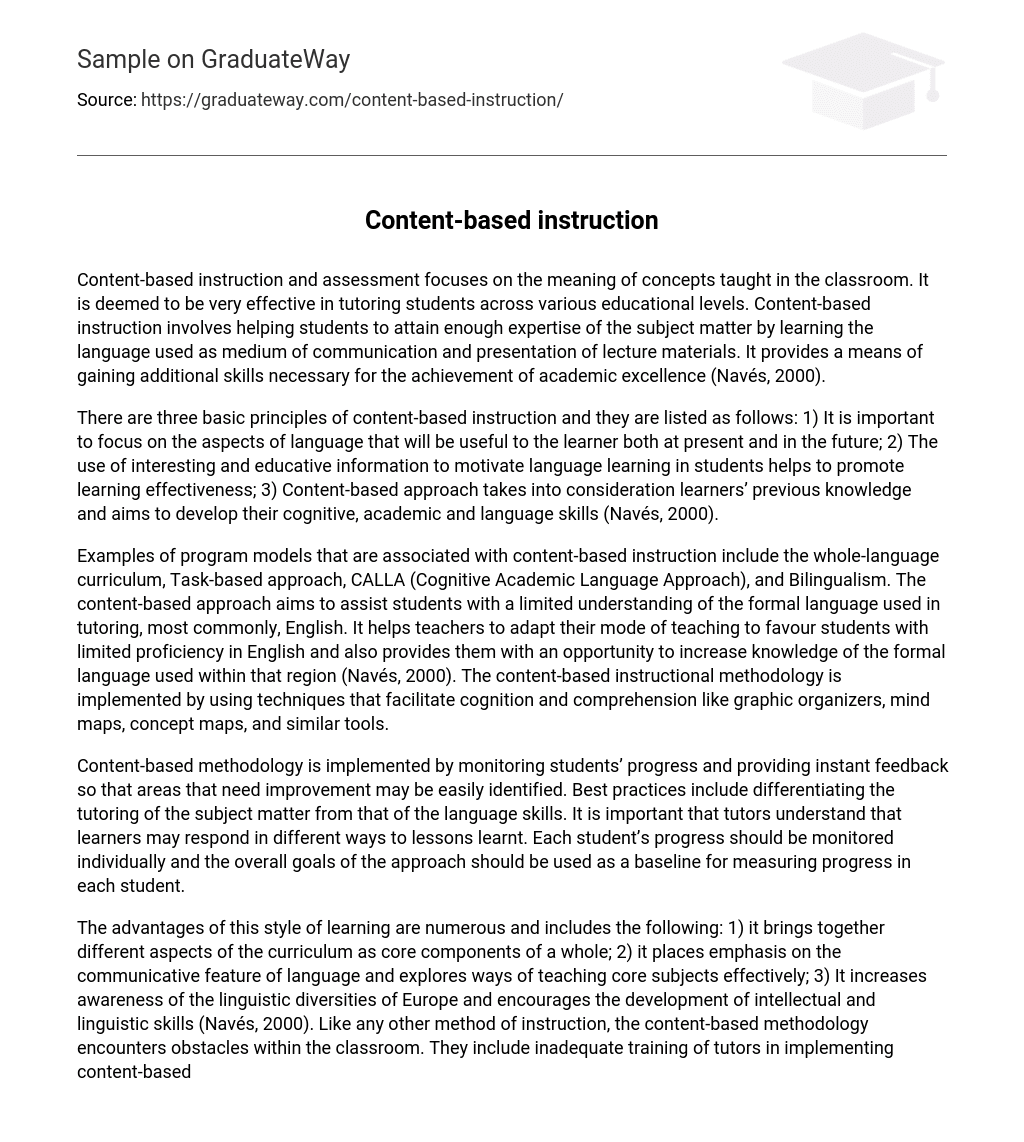Content-based instruction and assessment focuses on the meaning of concepts taught in the classroom. It is deemed to be very effective in tutoring students across various educational levels. Content-based instruction involves helping students to attain enough expertise on the subject matter by learning the language used as a medium of communication and presentation of lecture materials. It provides a means of gaining additional skills necessary for the achievement of academic excellence (Navés, 2000).
There are three basic principles of content-based instruction and they are listed as follows:
- It is important to focus on the aspects of language that will be useful to the learner both at present and in the future;
- The use of interesting and educational information to motivate language learning in students helps to promote learning effectiveness;
- Content-based approach takes into consideration learners’ previous knowledge and aims to develop their cognitive, academic and language skills (Navés, 2000).
Examples of program models that are associated with content-based instruction includes the whole-language curriculum, Task-based approach, CALLA (Cognitive Academic Language Approach), and Bilingualism. The content-based approach aims to assist students with a limited understanding of the formal language used in tutoring, most commonly, English. It helps teachers to adapt their mode of teaching to favor students with limited proficiency in English and also provides them with an opportunity to increase knowledge of the formal language used within that region (Navés, 2000). The content-based instructional methodology is implemented by using techniques that facilitate cognition and comprehension like graphic organizers, mind maps, concept maps, and similar tools.
Content-based methodology is implemented by monitoring students’ progress and providing instant feedback so that areas that need improvement may be easily identified. Best practices include differentiating the tutoring of the subject matter from that of the language skills. It is important that tutors understand that learners may respond in different ways to lessons learnt. Each student’s progress should be monitored individually and the overall goals of the approach should be used as a baseline for measuring progress in each student.
The advantages of this style of learning are numerous and includes the following:
- It brings together different aspects of the curriculum as core components of a whole;
- It places emphasis on the communicative feature of language and explores ways of teaching core subjects effectively;
It increases awareness of the linguistic diversities of Europe and encourages the development of intellectual and linguistic skills (Navés, 2000). Like any other method of instruction, the content-based methodology encounters obstacles within the classroom. They include inadequate training of tutors in implementing content-based methodologies; inadequate collaboration between the subject teacher and the language teacher; questionable proficiency levels of both teachers; insufficient instructional materials to help achieve and sustain this method of instruction; and difficulty in developing methods for assessing subject matter and language skills within the educational system (Navés, 2000).
Students all over the world use languages at different paces and with varying levels of proficiency. Scales of assessment and progress indicators need to be set up to measure if learning is taking place effectively and at the right pace. In order to assess content, it is necessary to evaluate how students interact with each other and the materials used to achieve this. Content assessment involves developing materials, tools, activities and criteria for evaluating how much learning is taking place. Various factors affect learning in the classroom. Experiences and individual beliefs affect how students respond to instruction. Classroom assessment methods should take this into consideration and allow students to express themselves individually. The methods employed for assessing content should be directed at achieving common learning goals and basic objectives of the subject matter. With the increase in the number of students across the globe, valid and reliable assessment methodologies should be developed and linked to learning through language (Navés, 2000).
Assessment of content is a comprehensive process that involves validating the contents of instructional materials used and ascertaining if learners can understand lesson contents easily. For Social Studies, content assessment can be achieved by using strategies that involve the use of interviews. These interviews can be conducted with both students and experts alike and the main aim would be to determine if the contents are effectively and delivered in the most appropriate manner. Sessions and discussion groups may also be initiated to propose suggestions aimed at developing and improving instructional strategies. Questionnaires targeted at determining the overall effectiveness of teaching materials and content may also be distributed. Conducting classroom sessions amongst students also help to ensure that they can understand and relate with learning materials or topics.
Assessment in Mathematics can be achieved by carrying out self and peer evaluations through tests, assignment reviews or corrections, quizzes, and group work. The full potential of these methods may utilize by exploiting the cognitive abilities of students with tools like Venn Diagrams, Flowcharts, Mind maps, concept maps, advance organizers, symbols, formulas and other methods that students can easily understand. With Science subjects, Knowledge surveys, case studies, written reports, presentations, and experiments are also diverse means for achieving effective content assessment.





